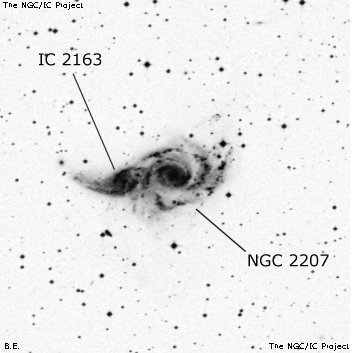NGC/IC Project Restoration Effort
(This is a very very beta version)
NGC2207


Basic Information
Location and Magnitude
Right Ascension: 6:16:21.8
Declination: -21:22:22
Constellation: CMA
Visual Magnitude: 10.9
Historic Information
Discoverer: Herschel J.
Year of discovery: 1835
Discovery aperture: 18.3
Observational
Summary description: pB, pL, mE 87°, pslbMRN
Sub-type: SBbc/P
Steve's Notes
=====
NGC 2207
48" (2/20/12): this beautiful spiral galaxy forms a stunning pair with IC 2163 attached to its east side. The center is sharply concentrated with a brilliant nucleus embedded in a very bright core. A mag 13.5 star is superimposed on the west-southwest edge of the core. A couple of beautiful, winding spiral arms are visible in the halo. An outer arm is on the southern end of the galaxy stretching to the west and curving counterclockwise north towards a mag 12.5-13 star situated 1.7' NW of center. A second more inner arm vaguely emerges on the west side of the core and wraps counterclockwise to the north, where it is parallel to the outer arm described above. This arms then curve back east of along the north side of the halo, stretching to the NE side of the halo, but not reaching IC 2163.
IC 2163 is attached at the east side of NGC 2207. The central region is very bright, round, ~1' diameter, small bright core. Attached on the southwest side is a spiral arm that gracefully sweeps to the east while curving gently clockwise. The arm is ~1.5' long and significantly increases the overall size to roughly 2'x1'. Just northeast of the tip of the arm is 2MASX J06163579-2122032, which appears as a faint, very small knot. This galaxy is probably a dwarf elliptical at the same distance as the pair.
18" (2/5/11): fairly bright, fairly large, sharply concentrated with a bright, elongated core (WSW-ENE) ~1' diameter and a large, much lower surface brightness halo ~2.5'x2.0'. A faint star is close WSW of the nucleus. A mag 13.5 star is at the NW edge of the halo.
Forms an interacting pair with IC 2163, which is embedded on the east side of the halo. The fainter companion appears fairly faint, moderately large, oval E-W, 1.0'x0.7', weakly concentrated
13.1" (1/28/84): moderately bright, moderately large, bright core, double nuclei. A faint extension is visible to the east. This is an unusual interacting pair and the extension to the east is IC 2163.



